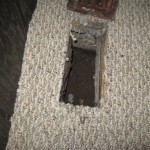What Is A Basement Floor Drain?
A basement floor drain is a plumbing fixture that is installed in the floor of a basement to collect and drain water. Floor drains are typically used to drain water from sinks, washing machines, water heaters, and other appliances. They can also be used to drain water from flooding or leaks.
Floor drains are typically made of cast iron or plastic and have a removable grate that allows water to flow into the drain. The grate is typically held in place by screws or bolts. Floor drains are connected to a drainpipe that leads to the sewer system.
Floor drains are an important part of a basement drainage system. They help to keep the basement dry and free of water damage. Floor drains should be inspected and cleaned regularly to ensure that they are functioning properly.
Types of Basement Floor Drains
There are two main types of basement floor drains:
- Gravity drains
- Sump pumps
Gravity Drains
Gravity drains are the most common type of basement floor drain. They work by using gravity to drain water from the basement. Gravity drains are typically installed in basements that are below the level of the sewer line. Water flows into the drain and then exits through the drainpipe to the sewer system.
Sump Pumps
Sump pumps are used in basements that are below the level of the sewer line. Sump pumps use a pump to lift water from the basement and then discharge it to the sewer system. Sump pumps are typically installed in a sump basin, which is a hole in the basement floor that is lined with a plastic or metal liner.
Choosing the Right Basement Floor Drain
The type of basement floor drain that you choose will depend on the specific needs of your basement. If your basement is below the level of the sewer line, you will need to install a sump pump. If your basement is above the level of the sewer line, you can install a gravity drain.
When choosing a basement floor drain, you should also consider the following factors:
- The size of the drain
- The material of the drain
- The cost of the drain
It is important to choose a basement floor drain that is the right size for your needs. The drain should be large enough to handle the amount of water that will be drained into it. The drain should also be made of a durable material that will not rust or corrode.
The cost of a basement floor drain will vary depending on the type of drain, the size of the drain, and the material of the drain. You should get quotes from several different contractors before you make a decision.
Installing a Basement Floor Drain
Installing a basement floor drain is a job that is best left to a professional plumber. However, if you are a do-it-yourselfer, you can install a basement floor drain yourself. The following steps will show you how to install a gravity drain.
Step 1: Choose a location for the drain
The first step is to choose a location for the drain. The drain should be located in a low spot in the basement where water is likely to accumulate. The drain should also be located near a drainpipe that leads to the sewer system.
Step 2: Cut a hole in the floor
Once you have chosen a location for the drain, you need to cut a hole in the floor. The hole should be large enough to accommodate the drain. You can use a saw or a drill to cut the hole.
Step 3: Install the drain
Once you have cut the hole in the floor, you need to install the drain. The drain should be installed according to the manufacturer's instructions. Most drains are installed by screwing them into the hole in the floor.
Step 4: Connect the drain to the drainpipe
Once the drain is installed, you need to connect it to the drainpipe. The drainpipe should be connected to the drain using a rubber coupling. The coupling should be tightened using a wrench.
Step 5: Test the drain
Once the drain is installed and connected to the drainpipe, you need to test the drain. To test the drain, pour water into the drain. The water should flow into the drain and then exit through the drainpipe to the sewer system.

Why Do I Have Standing Water In Basement Floor Drain

6 Types Of Basement Floor Drains

Floor Drain Basics Homesmsp Real Estate Minneapolis

Basement Floor Drain What You Need To Know About It

Floor Drains Finished Basements Best Practices Solutions Csg Renovation

Basement Floor Drain Keeping Your Home Dry

Why Did My Basement Floor Drain Back Up 1 Tom Plumber
Basement Floor Drain What They Are And When To Replace Them Mister Plumber

What Is A Foundation Drain Mmsd

6 Types Of Basement Floor Drains








